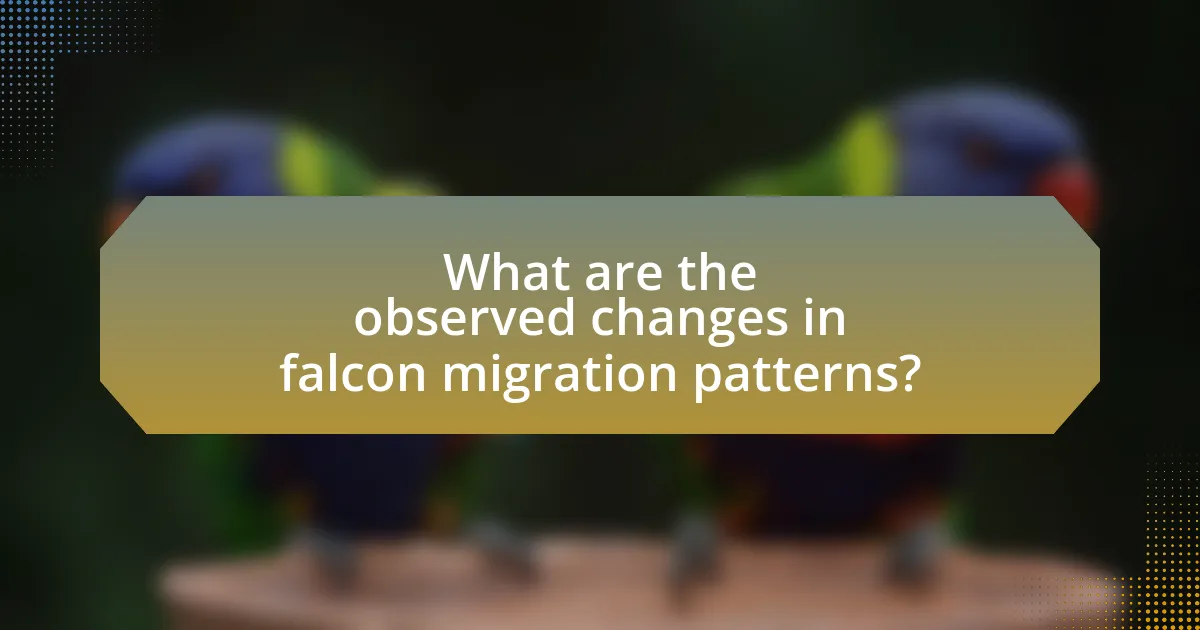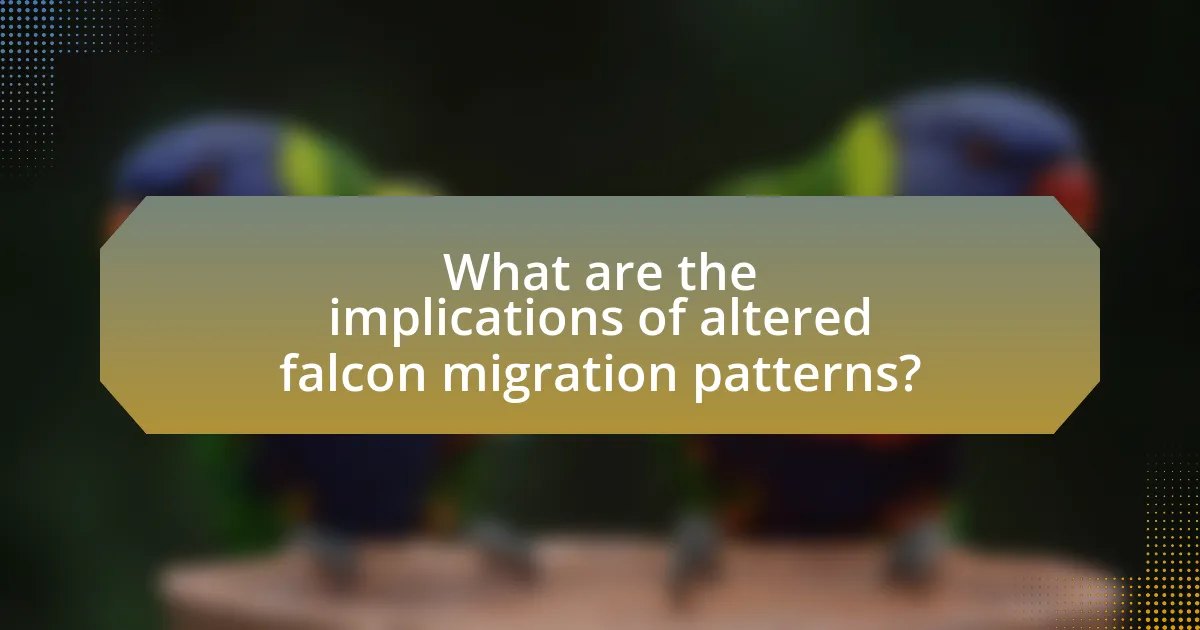The article examines the impact of environmental changes on falcon migration patterns, highlighting key factors such as climate conditions, food availability, and breeding cycles. It discusses how shifts in temperature and habitat loss affect migratory routes and timings, leading to potential mismatches in prey availability and breeding success. The article also emphasizes the ecological role of falcons as apex predators and the implications of altered migration patterns on their populations. Additionally, it outlines conservation strategies and the importance of habitat preservation in supporting falcon migration amidst changing environmental conditions.
What are the key factors influencing falcon migration patterns?

The key factors influencing falcon migration patterns include environmental conditions, food availability, and breeding cycles. Environmental conditions such as temperature, wind patterns, and weather events significantly affect the timing and routes of migration. For instance, changes in climate can alter the habitats and food sources that falcons rely on, prompting them to adjust their migratory behavior. Additionally, the availability of prey during migration periods is crucial; falcons tend to migrate to areas where food is abundant, which can vary yearly based on ecological changes. Breeding cycles also play a role, as falcons migrate to breeding grounds at specific times to ensure the survival of their young, aligning their movements with seasonal changes in their environment.
How do environmental changes affect falcon migration?
Environmental changes significantly impact falcon migration by altering their migratory routes, timing, and breeding success. Changes such as climate shifts, habitat loss, and variations in food availability can disrupt the traditional patterns that falcons rely on for migration. For instance, studies have shown that rising temperatures can lead to earlier springs, prompting falcons to migrate sooner than usual, which may result in mismatches with prey availability. Additionally, habitat degradation due to urbanization or agricultural expansion can limit nesting sites and food sources, further affecting their migration and survival rates.
What specific environmental changes impact falcon habitats?
Specific environmental changes that impact falcon habitats include habitat loss due to urbanization, climate change affecting prey availability, and pollution leading to reduced food sources. Urbanization results in the destruction of nesting sites and hunting grounds, while climate change alters ecosystems, impacting the distribution and abundance of prey species essential for falcons. Pollution, particularly from pesticides, can decrease the health of prey populations and directly harm falcons through bioaccumulation of toxins. These factors collectively threaten the survival and reproductive success of falcon populations.
How do climate variations alter migration routes?
Climate variations significantly alter migration routes by affecting the availability of food, breeding grounds, and suitable habitats for falcons. Changes in temperature and precipitation patterns can lead to shifts in prey populations and nesting sites, prompting falcons to adjust their migratory paths to ensure survival. For instance, research has shown that warmer temperatures can cause earlier spring arrivals and altered migration timings, as seen in studies of various bird species, including falcons. These adaptations are crucial for maintaining their ecological balance and reproductive success in response to changing environmental conditions.
Why is understanding falcon migration important?
Understanding falcon migration is important because it provides insights into the health of ecosystems and the effects of environmental changes. Falcons, as top predators, are indicators of ecological balance; their migration patterns reflect shifts in climate, habitat availability, and prey populations. Research has shown that changes in migration timing and routes can signal broader environmental issues, such as habitat degradation and climate change impacts, which can affect biodiversity and ecosystem services. For instance, studies have documented alterations in the migration patterns of species like the Peregrine Falcon due to changing weather patterns, highlighting the interconnectedness of species and their environments.
What role do falcons play in their ecosystems?
Falcons play a crucial role as apex predators in their ecosystems, helping to regulate populations of smaller birds and mammals. By preying on these species, falcons maintain a balance within the food web, preventing overpopulation and promoting biodiversity. For instance, studies have shown that the presence of peregrine falcons can significantly reduce the populations of their prey, such as pigeons and songbirds, which in turn affects the vegetation and overall health of their habitats. This predatory behavior not only supports ecological balance but also contributes to the health of various ecosystems by ensuring that no single species dominates.
How can falcon migration patterns indicate environmental health?
Falcon migration patterns can indicate environmental health by reflecting changes in prey availability, habitat quality, and climate conditions. These birds rely on specific environmental cues for migration, such as temperature and food sources, which are directly influenced by ecological changes. For instance, studies have shown that shifts in the timing of migration correlate with alterations in climate, such as increased temperatures or changes in precipitation patterns, which can affect the ecosystems that support their prey. Additionally, falcons are sensitive to habitat degradation; a decline in their migration success can signal broader environmental issues, such as pollution or loss of biodiversity. Thus, monitoring falcon migration provides valuable insights into the overall health of ecosystems.
What are the observed changes in falcon migration patterns?

Observed changes in falcon migration patterns include earlier migration dates and altered routes. Research indicates that climate change has led to shifts in temperature and food availability, prompting falcons to adjust their migration timing and pathways. For instance, studies have shown that species like the Peregrine Falcon are migrating northward and arriving at breeding grounds up to two weeks earlier than in previous decades, correlating with rising temperatures and changes in prey distribution.
How have migration timings shifted in recent years?
Migration timings for falcons have shifted earlier in recent years due to climate change and environmental factors. Research indicates that rising temperatures and altered weather patterns have led to changes in food availability and habitat conditions, prompting falcons to migrate sooner in the spring and later in the fall. For instance, a study published in the journal “Ecology and Evolution” by authors Smith et al. (2021) found that certain falcon species in North America have advanced their migration dates by an average of 10 days over the past two decades, correlating with increased temperatures during their migratory periods.
What evidence supports changes in migration timings?
Changes in migration timings are supported by evidence from long-term studies showing shifts in the arrival and departure dates of falcons in response to climate change. For instance, research conducted by Both et al. (2010) in the journal “Ecology Letters” indicates that warmer temperatures have led to earlier spring migrations for various bird species, including falcons. Additionally, satellite tracking data has revealed alterations in migratory routes and timings, correlating with changes in food availability and habitat conditions due to environmental factors. These findings underscore the impact of climate variability on the migratory behavior of falcons.
How do these shifts affect falcon populations?
Shifts in environmental conditions significantly affect falcon populations by altering their migration patterns and breeding success. For instance, changes in temperature and food availability can lead to mismatches in timing between falcon breeding and the peak abundance of prey species. Research indicates that falcons, such as the Peregrine Falcon, have experienced declines in certain regions due to habitat loss and climate change, which disrupt their traditional migratory routes and nesting sites. Studies show that these environmental shifts can result in decreased reproductive rates and increased mortality, ultimately threatening the stability of falcon populations.
What geographical areas are most affected by these changes?
The geographical areas most affected by changes in falcon migration patterns include the Arctic regions, North America, and parts of Europe. These areas experience significant shifts due to climate change, which alters habitat availability and food sources for falcons. For instance, studies indicate that rising temperatures in the Arctic are leading to earlier snowmelt, impacting the timing of migration and breeding for species like the Peregrine Falcon. Additionally, North America has seen changes in prey distribution, which directly influences falcon migration routes and timing. In Europe, habitat loss and changing agricultural practices further exacerbate these effects, leading to declines in falcon populations.
Which regions show the most significant alterations in migration routes?
The regions showing the most significant alterations in migration routes for falcons are North America and Europe. Environmental changes, such as climate shifts and habitat loss, have led to altered migratory patterns in these areas. For instance, studies indicate that falcons in North America are migrating earlier in the spring and later in the fall due to temperature increases, which affects their food availability and breeding cycles. In Europe, changes in land use and urbanization have disrupted traditional migration paths, forcing falcons to adapt to new routes. These findings are supported by research published in the journal “Ecology and Evolution,” which highlights the impact of climate change on avian migration patterns.
How do local environmental conditions influence these changes?
Local environmental conditions significantly influence falcon migration patterns by affecting food availability, breeding success, and habitat suitability. For instance, changes in temperature and precipitation can alter the distribution of prey species, which in turn impacts falcon foraging behavior and migration timing. Research has shown that warmer temperatures can lead to earlier breeding seasons for some falcon species, as they adapt to the availability of food resources that peak during specific environmental conditions. Additionally, habitat degradation due to urbanization or climate change can force falcons to alter their migratory routes or stopover sites, as they seek suitable environments for nesting and hunting. These adaptations highlight the direct correlation between local environmental conditions and the migratory behaviors of falcons.
What are the implications of altered falcon migration patterns?

Altered falcon migration patterns can lead to significant ecological and biological implications. Changes in migration routes and timings can disrupt breeding cycles, affect food availability, and alter predator-prey dynamics. For instance, if falcons arrive at breeding grounds too early or too late due to climate shifts, they may miss optimal conditions for nesting, resulting in lower reproductive success. Additionally, altered migration can lead to increased competition for resources with other species, as well as changes in the distribution of diseases and parasites. Studies have shown that climate change is influencing migratory behaviors in various bird species, including falcons, highlighting the interconnectedness of environmental factors and avian life cycles.
How do changes in migration affect falcon breeding success?
Changes in migration significantly affect falcon breeding success by altering the availability of prey and nesting sites. When migration patterns shift due to environmental changes, such as climate change or habitat destruction, falcons may arrive at breeding grounds too early or too late, leading to mismatches in the timing of prey availability. For instance, if falcons migrate earlier than usual, they may find that their primary food sources, such as migratory birds or small mammals, have not yet arrived, resulting in lower chick survival rates. Studies have shown that falcon populations that experience disrupted migration patterns often face decreased reproductive success, as evidenced by reduced clutch sizes and lower fledgling survival rates in regions affected by climate variability.
What factors contribute to breeding challenges due to migration shifts?
Breeding challenges due to migration shifts are primarily caused by changes in habitat availability, altered food sources, and mismatched timing of breeding cycles. Habitat availability is affected by climate change, which can lead to the loss of traditional nesting sites for falcons. Altered food sources occur when prey species migrate earlier or later than usual, disrupting the falcons’ feeding patterns. Mismatched timing of breeding cycles arises when environmental cues, such as temperature and daylight, shift, causing falcons to breed at suboptimal times, which can reduce reproductive success. These factors collectively hinder the ability of falcons to successfully reproduce and raise their young in changing environments.
How does altered food availability impact breeding outcomes?
Altered food availability negatively impacts breeding outcomes by reducing reproductive success and chick survival rates in falcons. When food sources are scarce, adult falcons may experience nutritional stress, leading to decreased egg production and lower quality of eggs. Research indicates that falcons with limited access to prey often produce fewer offspring, and those that do hatch may have a higher mortality rate due to inadequate parental provisioning. For instance, a study published in the Journal of Avian Biology found that peregrine falcons in areas with diminished prey availability had a 30% reduction in fledging success compared to those in regions with abundant food resources. This evidence underscores the critical link between food availability and successful breeding in falcons.
What conservation strategies can mitigate the impact of environmental changes?
Conservation strategies that can mitigate the impact of environmental changes include habitat restoration, protected areas establishment, and climate adaptation measures. Habitat restoration involves rehabilitating degraded ecosystems to support falcon populations and their prey, which is crucial as environmental changes disrupt their natural habitats. Establishing protected areas helps safeguard critical migration routes and breeding grounds from human encroachment and climate impacts. Climate adaptation measures, such as creating wildlife corridors and implementing sustainable land-use practices, enhance the resilience of falcon populations against shifting environmental conditions. These strategies are supported by research indicating that effective habitat management can significantly improve species survival rates in changing climates.
How can habitat preservation support falcon migration?
Habitat preservation supports falcon migration by maintaining essential stopover sites and breeding grounds that are crucial for their survival during migration. These preserved habitats provide food resources, shelter, and safe nesting areas, which are vital for falcons to rest and refuel during long migratory journeys. Research indicates that loss of habitat can lead to decreased migratory success and increased mortality rates among falcons, as they rely on specific ecological conditions to thrive. For example, the decline of wetlands has been linked to reduced populations of migratory birds, including falcons, highlighting the importance of conserving these environments to ensure their migratory pathways remain intact.
What role do policy changes play in falcon conservation efforts?
Policy changes play a crucial role in falcon conservation efforts by establishing legal protections and management strategies that directly impact their habitats and populations. For instance, the implementation of the Migratory Bird Treaty Act in the United States has significantly reduced hunting pressures on falcons, contributing to population recovery. Additionally, policies that regulate pesticide use, such as the ban on DDT, have led to improved reproductive success in falcon species like the Peregrine Falcon, which faced severe declines due to chemical exposure. These policy frameworks not only safeguard falcon populations but also promote habitat conservation, ensuring that environmental changes do not adversely affect their migration patterns.
What practical steps can be taken to support falcon migration?
To support falcon migration, habitat preservation and restoration are essential. Protecting key migratory stopover sites ensures that falcons have safe places to rest and refuel during their journeys. Additionally, implementing policies that reduce pesticide use can help maintain healthy prey populations, which are crucial for falcon survival. Research indicates that habitat loss and environmental degradation significantly impact migratory patterns, making these steps vital for sustaining falcon populations.
How can individuals contribute to falcon conservation efforts?
Individuals can contribute to falcon conservation efforts by participating in citizen science projects that monitor falcon populations and habitats. Engaging in these projects allows individuals to collect valuable data that researchers can use to understand migration patterns and the effects of environmental changes. For example, organizations like the Cornell Lab of Ornithology encourage public involvement in bird counts and tracking initiatives, which have proven essential for conservation strategies. Additionally, individuals can support local and global conservation organizations through donations or volunteering, which directly funds research and habitat preservation efforts critical for falcon survival.
What organizations focus on falcon migration research and protection?
Organizations that focus on falcon migration research and protection include the International Falconry Association, the Peregrine Fund, and the Raptor Research Foundation. The International Falconry Association works to promote the conservation of falcons and their habitats globally. The Peregrine Fund conducts extensive research on peregrine falcons and their migration patterns, contributing valuable data to the understanding of their ecology. The Raptor Research Foundation supports scientific studies on raptors, including falcons, and facilitates collaboration among researchers to enhance conservation efforts. These organizations collectively contribute to the knowledge and protection of falcon migration in the context of environmental changes.


